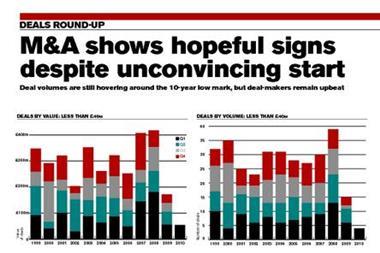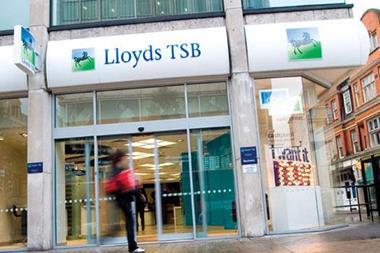With any merger or acquisition only having a 50% chance of success, it’s not strategy or money clashes that make or break a union but culture
It is widely predicted that the insurance market is set for a marked rise in M&A activity. But as the latest and increasingly messy proposed deal between Prudential and AIA splashes across the headlines, it is further proof that M&As rarely go to plan.
Earlier this year, Marsh & McLennan president and chief executive Brian Duperreault told delegates at the World Insurance Forum in Bermuda that any planned M&A only had a 50/50 chance of success. These poor odds, he believes, are mainly down to the frequent failure of the cultures of the two companies to gel together.
“The cultures have to match from the start. If there is some different value you see in their culture, you are going to end up destroying it,” he said. “The biggest cost of any M&A can be bringing the two cultures in line, leading to a loss of talent”.
There is little question that an M&A can be a traumatic process for many involved. But what exactly is a culture – and where has it gone right and wrong? All culture really means is people – how they do their jobs and how they behave towards one another. There is little question that an M&A can be a traumatic process for many of the staff involved.
Last year’s $1.5bn (£1.01bn) Aon Benfield merger led a number of former Benfield players into the arms of rivals. And QuestGates chief executive Chris Hall has described the fall out of the ill-fated merged between Capita and his former home McLaren Dick & Co as the lowest point in his career.
Marriage of equals
Corporate transition expert and professor at the faculty of business in San Francisco State University, Mitchell Lee Marks, believes that M&As are rarely an alignment of equals. He claims that when one company buys another there is inevitably “an insinuation that I’m better than you”. This can lead to the employees of the more powerful company dominating their new colleagues, especially if they were previously rivals.
It’s all too familiar to Aon Benfield co-chief executive Dominic Christian, who headed up Benfield’s international division before the merger. “You do have to look at the challenge of how do you make friend your enemy,” he admits. Of a past M&A, he says: “We had 80 businesses and we didn’t get to one company quickly enough to tell our story, and in those circumstances people feel they can’t understand what is new. You notice the difference if you don’t get to everyone in a quick and approachable way.”
The Aon Benfield merger took several months to complete and a substantial reshuffle of the senior management team. But Christian believes that while the loss of some individuals is inevitable, he argues the high retention of senior leaders from both companies is a testament of success. “In our case, 95% of the leaders have stayed. That is a statement that we have a culture that works,” he says firmly.
Keep the best bits
XL Insurance’s UK head of client relationship management, Nigel Bamber, believes that ensuring a blend of the best of both cultures ensured a successful integration when the insurer merged with Winterthur International in 2001. “There was a difference in cultures. XL was more of an underwriting-driven company and Winterthur was more of a marketing-led company,” he explains.
He believes that as XL had previously been closer to brokers, the acquisition of Winterthur helped cultivate better relationship with clients. “That was down to good communication and taking the best bits of both companies. You need a blend: not forgetting that underwriting is very important and critical for understanding clients’ risk, but at the same time being very customer-focused.”
Chairman of consultancy People in Business, Simon Barrow, points to the Hiscox acquisition of Economic Insurance in 1996 as an example of a successful M&A. Then, Hiscox was primarily a Lloyd’s underwriter with a modest retail business concentrated on high net worth individuals. “It needed a platform on which to build a major retail business under the Hiscox brand,” he says.
He adds that the acquired company’s employees here were receptive to change because they felt the new regime would complement their existing culture. And Economic Insurance employees felt this option compared favourably to the alternatives offered by rival bidders. “What Hiscox provided was a clear vision of what a great business opportunity was available. While that sounds one-sided, Hiscox was welcomed as the acquirer.”
Don Harrison, president of Implementing Management Insights, a consultancy specialising in organisational change, says: “85% of M&As fail to deliver on time and on budget what they promised their shareholders. In the vast majority, it is not strategic or economic issues: it is cultural issues that fail to get the return on investment.”
There are many scenarios that can lead to culture clash. Every company has a specific company culture and a set of unwritten rules or success patterns that have become deeply engrained. These can manifest in different ways, such as dress sense, attitudes towards time-keeping and approaches to climbing the corporate ladder.
For example, in one company, an employee may have learnt that touting an idea as far up the management hierarchy as possible is the path to promotion. But, in the other company, going above your immediate boss could lead to a major furore.
Further, different attitudes towards leadership can create confusion. One company may be driven by a powerful set of leaders, while the other promotes a more collaborative approach. One company may have a teamwork-led culture while the other may foster the belief that confrontation and criticism forces people to work harder and produce the best ideas.
Getting closer
Failure to even acknowledge the existence of culture in the first place can generate problems. “Some companies in the conservative insurance sector are not even sure how their own culture operates, let alone the culture of another company they have acquired,” Harrison explains.
He says there are ways that cultural integration can achieved including workshops, focus groups, surveys and individual interviews. He also describes a process called “yoking” – where one manager in one organisation swaps places with a manager in another to get a sense of how the different companies work and to blend styles.
Christian explains that following the merger, the company blended ideas from both companies to form an “educational programme led by future leaders” to enthuse employees.
Bamber points out the simple act of moving both sets of employees into one building helped to distil the two cultures. It seems that navigating M&As will remain a tricky business. But one thing is certain. As the insurance market moves towards a period of increasing consolidation, those in the steering wheel ignore the importance of culture at their peril. IT






































No comments yet